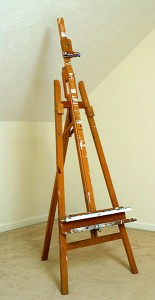Types of Painting Easels: An Introduction

Dictionary.com defines easel as “a stand or frame for supporting or displaying at an angle an artist’s canvas.” Easels are usually made of wood, steel, or aluminum and are available in different designs. Here are the different types of easels in the market:
1. A-frame or Lyre easel. The A-frame easel has a tripod design, meaning, two legs in front and one in the back. It provides a strong base for your painting and it’s small size makes it easy to move and store in your studio. The legs are collapsible so you can just fold the legs and keep it in your storage when you’re done painting. If you have a small space, an A-frame easel is perfect since it will not crowd your studio. A-frame easels can hold small size canvases up to 75″ canvases.
2. H-frame easel. As the name suggests, an H-frame easel looks like the letter “H.” It has parallel vertical posts and a horizontal crossbar support. It gives sturdier support compared to A-frame easel but it’s quite bulky. An H-frame easel can hold bigger canvases, up to 84″-96″.
3. Single mast easel. The single mast easel is the simplest type of easel. It doesn’t offer the same support as the A-frame and H-frame easels but because of its affordability, many art students and beginners opt to use it. It occupies less space (great for small apartments and school studios), is collapsible, and easy to store.
4. Giant easel. The giant easel is made for artists doing large-scale paintings. It can handle canvases taller than 8 ft so naturally, this easel is stronger and sturdier. Due to its weight, transporting a giant easel is not easy. If you are consistently working on large-scale paintings, use a giant easel but make sure that you have a dedicated studio where you can use and store it.
5. Convertible easel. The convertible easel, also called hybrid easel, is the most versatile among all other easels. You can position your canvas horizontally or vertically, depending on the surface needed by the medium you’re using. This easel can accommodate the needs of painters using oil, acrylics, watercolor, and pastels. If you’re an artist who uses several media, the convertible easel is best for you.
6. Table top easel. The table top easel can be placed on a table and allows the artist to sit while painting. It is great for those who work on small-scale paintings and those who have limited space in their room or studio. It is portable and stores easily.
7. Plein air easel. The plein air easel is the easel that you can use outdoors. It has tripod legs and can have drawers and shelf to hold your painting supplies and materials. It can hold canvases up to 45″-78″ high.
8. Bench easel. The bench easel combines an easel and a bench. The design allows you to sit while painting. It is collapsible so you can bring it anywhere. It is great for plein air artists, art teachers, or for those giving demonstrations.
9. Display easel. The display easel is not for painting, just for displaying paintings only. It is made of lighter material so it cannot hold heavy artworks. Use the display easel when you are having an art show or any event where you need to showcase your work.
10. Children’s easel. The children’s easel is created for kids. It is adjustable and most designs have two sides, allowing a couple of children to work on their paintings. It offers built-in storage where children can keep their art supplies.
Image source: www.wikipedia.org